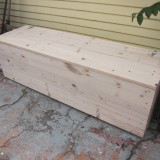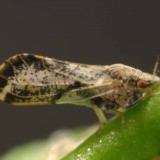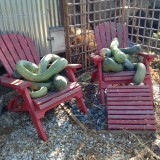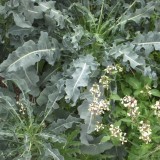
This is related to my recent post about our flowering radish. It’s a tale of botanic dumpster diving and another reason why you should let your food plants go to flower when you can.
Last year I threw the crown (which is to say, the bottom) of a celery plant in my worm bin. I probably should have chopped it up for the worms’ sake, but I didn’t. Later, sometime in the fall, I rediscovered the celery crown. Instead of rotting in the bin, it had sprouted leaves and looked surprisingly vigorous. So I pulled it out and popped it into an empty space in one of our raised beds.
I didn’t have much hope. Celery doesn’t like our climate much, and I consider it one of those plants which is easier to buy than to grow.
To my surprise, the plant did quite well, though it did have a feral quality to it, despite its mild domestic origins. It didn’t grow fat, moist stalks which can be used to scoop up peanut butter. It grew stringy, dark green stalks which tasted powerfully of celery. It made excellent stock, and chopped into fine pieces, it was good in soup, too. Since I don’t eat much raw celery, this suited me fine.
All winter long I used this plant as the basis of my cold-weather cooking–chopped onions, carrots and celery in the bottom of every pot. It was a real treat not to have to buy celery for such a long time, and to have that flavor available whenever I wanted it. I should add that the leaves were just as flavorful as the stalks
As a side note, I’ve heard of a breed of celery made to work precisely this way, called cutting celery, but I’ve never grown it intentionally. The celery in this post looks very much like my homegrown “cutting celery.” Perhaps commercial celery wants to revert to this?
Months later, the hot weather arrived, the celery started to bolt (that is, send up flower stalks). When a plant bolts, it puts all its energy into flowering. At that point, its not much use to us as food. I was sad to lose my bottomless celery supply, but I was excited about the flowers.
Pollinating insects love celery blossoms. Actually, they adore the whole family of plants to which celery belongs, called Apiaceae or Umbelliferae (which I tend to call Umbrella Fae, which is wrong, but right in my head). This family includes carrots, celery, dill, coriander, fennel, Queen Anne’s lace, etc. If you can let any of this family bloom in your garden, do.
The parsley flowers grew almost as tall as me, and they were surrounded by clouds of tiny insects every day –shy, tiny little pollinators that I can’t name.
I love to let things go to flower and seed in the garden, because it is a way of giving back to the rest of nature. Flowers for the insects, seeds for birds. And by giving back, you help balance your garden. We’ve had significantly less issues with destructive insects since we learned to let our garden go a little wild.
Sadly, this celery never got to seed, because it collapsed under its own weight one day. Its thick, hollow stalks folded and the head of the plant fell to the patio. I had hoped to save a little seed and try to grow a plant the next year from scratch. But now I’m thinking I’m going to throw a whole crown of celery in the worm bin this fall, and hope this happens all over again.





Lovely story and a testament to what value lies in “garbage”.
As an aside, when my Umbelliferae plants send up their seed stalks, I put one of those inexpensive round tomato cages around them. The cages are a bit flimsy for robust tomato plants, but they’re great for supporting lettuce, celery, beets, and other plants that have gone to seed. These seed stalks can be quite fragile; one thunderstorm and they’re on the ground.
Oh, now that’s a good idea!
I live in a colder climate than you do, but I dig up a couple of celery plants in the fall and winter them in a cold room in my house in pots. I use them all winter as you described. In the spring I plant them in the garden again so they can flower and go to seed. I would love to see your garden. It sounds like we garden a lot alike, even tho I live in Maine!
I put the stump of the celery in a bowl with about a quarter inch of water which I refreshed every day. When the center started to rise up, growing little leaves, I put it in a pot of dirt, just barely sinking it in the dirt. It continued to grow. As I was trying to survive the aftermath of a tornado, I ignored it and it died. It was growing leaves right out of the stump, then stalks came next. It was strange and fun to watch. From what I have read since, I think this is how grocery store umbrella reacts to replanting.
The little flowers in your garden are very pretty. They make me want to try again.
Grocery store umbrella??? I meant “grocery store celery.”
hmm…the umbrella fae thing is catching…
Great post! It’s so interesting to learn new things about plants, simply by letting them show us what they can do.
I remember being surprised at what some leeks did after they wintered over… they looked a bit like the walking onions, with an aerial cluster of tiny bulblets. And the parsnips which weren’t dug sprouted impressive tops that attracted the big black (swallowtail?) butterflies. Such fun to experiment.
I’m in Portland, OR and our celery plant – tucked into the garden on a whim a couple of years ago – has been doing fine. We had similar results – very few big fat stalks for eating fresh, but plenty for using in cooked dishes. It’s been nice having the whole mirepoix come from the garden. We’ve left the bolted plant alone mostly because we’re lazy. Now I can say I’m doing it on purpose! Thanks 🙂
Hi Kelly,
Great photos! I grew celery for the first time last year–it’s supposed to do well here in the PNW. I didn’t treat it well, and it only did ok in the summer. But I left it to overwinter, and in the spring, it was awesome: lots of leaves for salads, small stalks as you describe for soups and cooking.
This family of plants, which are mostly root veg as you say, are biennials. They are designed to produce our juicy foods the first year, overwinter, and then use all that stored sugar to produce seed the next year. So there’s nothing special about this particular celery in that regard–the same thing should happen with any celery root; it’s not “bolting” per se in your warm climate. So buy a good bunch and again throw the root in the garden!
I rarely leave root veg in the ground, even though I know how useful the flowers are, so I’ve been thrilled to see the beautiful celery flowers covered with insects. I’m hoping for seed too; I’ll heed your warning and give the stalks some support!
Ah, it’s a biennial. That makes sense!
I’ve had luck growing lovage–it is a perennial herb and tastes like strong celery. It is great for drying and adding to soups in the winter, eating fresh or adding fresh to cooked stuff. And it grows hugely and spreads into a giant clump (I live in NW Wisconsin, but I have a feeling lovage will grow anywhere).
I was going to post about lovage… but I couldn’t remember it’s name:)
I’ve had mine for years and use it in place of celery(which I don’t like) it gives just a hint of flavor.
I may try and grow some though just for the pretty plant.
I’ve tried lovage too. It did fairly well here in LA. As I recall (it’s been a few years) it behaved like parsley in our climate, meaning it did not like the heat of the summer so much, but was ok the rest of the year. It stayed pretty tame in its corner of the herb bed. Very pretty leaves!
My Lovage plant in the UK hasn’t spread out too much, but it’s 3 or 4 years old and a good 8 foot tall!
good lord! mine never got above 18 inches!
After reading that celery can be difficult, and also that it can sprout anew from its “stump,” I unceremoniously tossed mine in the dirt. Needless to say, that did not amount to much in my climate. I recently purchased some gorgeous “peppermint stick” celery seed to try this fall.
I am a huge proponent of letting umbrella fae (ha) go to seed. I am feeling guilty because I plan on harvesting all of my fennel blooms this year to make fennel liqueur.
fennel liqueur from fennel blooms? do tell more!
(though yeah, I think I’d have a yard riot if I cut the fennel flowers…)
Well if you happen upon a bunch of fennel blossoms, I highly recommend it!
http://dulcisinfurno.blogspot.com/2010/08/liquore-al-finocchietto-selvatico.html
I’ve enjoyed it in Italy, but I’m making my own this summer.
We do grow what you refer to as cutting celery. We call it safir, and it is a lot like what you desribe, though the stalks are so thin they resemble Italian parsley more than celery. I chop and freeze it to use in soups all winter and always let it make seed for the next planting. It self seeds readily, so unless I’ve been careless, I always have the first-year growth that is best as with any biennial.
Your title says “Worm Bin Parsley”, but the post is about celery. 🙂 Did I miss something? At any rate, very interesting. I’ve never tried to grow celery at all, but more and more I’m amazed at what vegetable plants will do if left to there own devices. I have radishes all over the garden this year, even in the paths, because I let some go to seed last year.
Argggggh!!!!The creeping senility!
Fixed.
Thanks.
Commercially grown salad celery has been blanched by being partially buried in mulch to keep the sun off the stalks.
My husband brought joy to our garden ever since he spotted an abandoned flat of celery on the side of the 101 freeway in Oxnard! I have had years of plants from that one single flat. I mostly collect the seed which is lovely in potato salads, etc. Beneficial insects love it too!